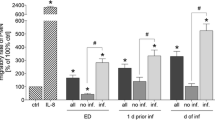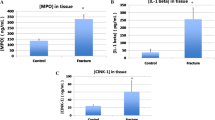Abstract
Purpose
Dysregulation of polymorphonuclear neutrophil (PMN) biology is associated with the development of inflammatory complications after trauma, such as acute respiratory distress syndrome (ARDS). It has been demonstrated that intramedullary nailing is both associated with altered pulmonary neutrophil deposition and the occurrence of ARDS. This standardized study aimed to characterize the long-term remote neutrophil response in the lungs in case of a femur fracture and intramedullary nailing.
Methods
A standardized rat model including intramedullary nailing and a femur fracture was utilized. Groups were terminated after observation times of three, seven and 14 days. Neutrophils were isolated from lung parenchyma and broncho-alveolar lavage fluid (BALF) and analyzed by flow cytometry. Absolute neutrophil numbers as well as membrane expression levels of CD11b, CD62L, and CD11a were compared.
Results
Pulmonary neutrophil numbers were increased 3 days after intervention. Membrane expression levels of CD11b (P < 0.01), CD62L (P < 0.01), and CD11a (P = 0.06) on parenchymal PMNs increased as well after 3 days. Thereafter, values restored gradually to physiological levels. Furthermore, neutrophil activation status patterns between parenchymal and BALF neutrophil pools did not correlate.
Conclusions
The current study demonstrates that IMN and a femur fracture are associated with transient increased pulmonary PMN deposition, as well as a specific pattern of activation characterized by temporary increased selectin and integrin receptor expression on pulmonary neutrophils. This phenomenon might play an important role in the pathomechanism of ARDS after IMN. Moreover, we found striking differences between parenchymal and BALF-neutrophil populations, demonstrating the limited readout potential of BALF analysis to investigate the entire pulmonary neutrophil pool.




Similar content being viewed by others
References
Pape HC, Auf‘m’kolk M, Paffrath T, Regel G, Sturm JA, Tscherne H (1993) Primary intramedullary femur fixation in multiple trauma patients with associated lung contusion--a cause of posttraumatic ARDS? J Trauma 34(4):540–547 discussion 547-8
Dunn RH, Jackson T, Burlew CC, Pieracci FM, Fox C, Cohen M, Campion EM, Lawless R, Mauffrey C (2017) Fat emboli syndrome and the orthopaedic trauma surgeon: lessons learned and clinical recommendations. Int Orthop 41(9):1729–1734. https://doi.org/10.1007/s00264-017-3507-1
van Griensven M , Krettek C, Pape HC (2003) Immune Reactions after Trauma. Eur J Trauma 29:181. https://doi.org/10.1007/s00068-001-1324-z
Brown KA, Brain SD, Pearson JD, Edgeworth JD, Lewis SM, Treacher DF (2006) Neutrophils in development of multiple organ failure in sepsis. Lancet 368(9530):157–169
Pape HC, Remmers D, Kleemann W, Goris JA, Regel G, Tscherne H (1994) Posttraumatic multiple-organ failure-a report on clinical and autopsy findings. Shock 2(3):228–234
Stoermann P, Wagner N, Koehler K, Auner B, Simon TP, Pfeifer R, Horst K, Pape HC, Hildebrand F, Wutzler S, Marzi I, Relja B (2019) Monotrauma is associated with enhanced remote inflammatory response and organ damage, while polytrauma intensifies both in porcine trauma model. Eur J Trauma. https://doi.org/10.1007/s00068-019-01098
Relja B, Taraki R, Teuben MP, Mörs K, Wagner N, Wutzler S, Hildebrand F, Perl M, Marzi I (2016) Sera from severe trauma patients with pneumonia and without infectious complications have differential effects on neutrophil biology. BMC Pulm Med 16(1):171
Barletta KE, Cagnina RE, Wallace KL, Ramos SI, Mehrad B, Linden J (2012) Leukocyte compartments in the mouse lung: distinguishing between marginated, interstitial, and alveolar cells in response to injury. J Immunol Meth 375(1-2):100–110
Aulakh GK (2018) Neutrophils in the lung:´the first responders´. Cell Tissue Res 371(3):577–588
Granton E, Kim JH, Podstawka J, Yipp BG (2018) The lung microvasculature is a functional immune niche. Trend Immunol 39(11):890–899
Roger N, Xaubet A, Agusti C, Zabala E, Ballester E, Torres A et al (1995) Role of bronchoalveolar lavage in the diagnosis of fat embolism syndrome. Eur Respir J 8:1275–1280
Blankstein M, Byrick RJ, Nakane M, Bang KW, Freedman J, Richards RR et al (2010) Amplified inflammatory response to sequential hemorrhage, resuscitation, and pulmonary fatembolism: an animal study. JBJS Am 92(1):149–161. https://doi.org/10.2106/JBJS.H.01141
Bonnarens F, Einhorn TH (1984) Production of a standard closed fracture in laboratory animal bone. J Orthop Res 2(1):97–101
Kobbe P, Vodovotz Y, Kaczorowski DJ, Mollen KP, Billiar TR, Pape HC (2008) Patterns of cytokine release and evolution of remote organ dysfunction after bilateral femur fracture. Shock 30(1):43–47
Skrajnar S, Anzur Lasnik M, Bedina Zavec A (2009) A flow cytometric method for determination of the blood neutrophil fraction in rats. J Am Lab Anim Sci 48(2):145–156
Simon SI, Rochon YP, Lynam EB, Smith CW, Anderson DC, Sklar LA (1993) Beta 2-integrin and L-selectin ae obligatory receptors in neutrophil aggregation. Blood 82(4):1097–1106
Ivetic A (2018) A head-to-tail view of L-selectin and its impact on neutrophil behavior. Cell Tiss Res 371(3):437–453
Neeley SP, Hamann KJ, White SR, Baranowski SL, Burch RA, Leff AR (1993) Selective regulation of expression of surface adhesion molecules Mac-1, L-selectin, and VLA-4 on human eosinophils and neutrophils. Am J Respir Cell Mol Biol 8:633–639
van Wessem KJP, Heeres M, Leliefeld PHC, Koenderman L, Leenen LPH (2013) Lipopolysaccharide and hemorragic shock cause systemic inflammation by different mechanisms. J Trauma 74(1):37–44
Pillay J, Kamp VM, van Hoffen E, Visser T, Tak T, Lammers JW, Ulfman LH, Leenen LP, Pickkers P, Koederman L (2012) A subset of neutrophils in human systemic inflammation inhibits T cell responses through Mac-1. J Clinic Invest 122(1):327–336
Cocks RA, Chan TY, Rainer TH (1998) Leukocyte L-selectin is up-regulated after mechanical trauma in adults. J Trauma 45(1):1–6
Bruhns P (2012) Properties of mouse and human IgG receptors and their contribution to disease models. Blood 119(24):5640–5649
Lefort CT, Ley K (2012) Neutrophil arrest by LFA-1. Front Immunol 3:157
Hietbrink F, Koenderman L, Althuizen M, Pillay J, Kamp V, Leenen LPH (2013) Kinetics of the innate immune response after trauma: implications for the development of late onset sepsis. Shock 40(1):21–27
Anderson BO, Brown JM, Harken AH (1991) Mechanisms of neutrophil-mediated tissue injury. J Surg Res 51(2):170–179
Author information
Authors and Affiliations
Corresponding author
Additional information
Publisher’s note
Springer Nature remains neutral with regard to jurisdictional claims in published maps and institutional affiliations.
Electronic supplementary material
ESM 1
(BMP 2700 kb)
Rights and permissions
About this article
Cite this article
Teuben, M.P.J., Hofman, M., Shehu, A. et al. The impact of intramedullary nailing on the characteristics of the pulmonary neutrophil pool in rodents. International Orthopaedics (SICOT) 44, 595–602 (2020). https://doi.org/10.1007/s00264-019-04419-6
Received:
Accepted:
Published:
Issue Date:
DOI: https://doi.org/10.1007/s00264-019-04419-6




